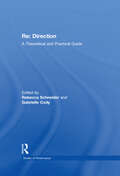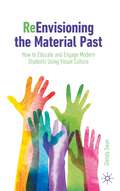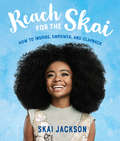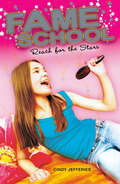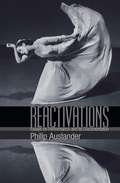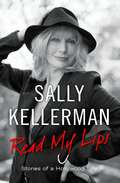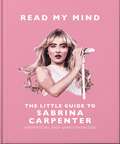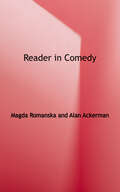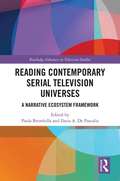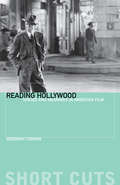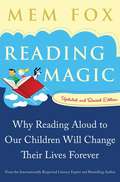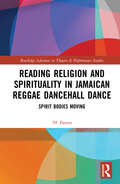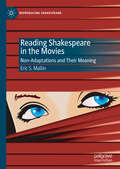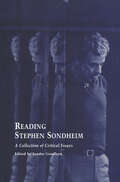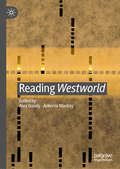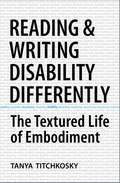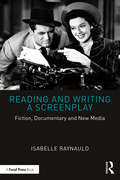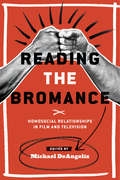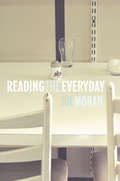- Table View
- List View
Re: A Theoretical and Practical Guide (Worlds of Performance)
by Gabrielle Cody Rebecca SchneiderRe: Direction is an extraordinary resource for practitioners and students on directing. It provides a collection of ground-breaking interviews, primary sources and essays on 20th century directing theories and practices around the world. Helpfully organized into four key areas of the subject, the book explores: * theories of directing * the boundaries of the director's role * the limits of categorization * the history of the theatre and performance art. Exceptionally useful and thought-provoking introductory essays by editors Schneider and Cody guide you through the wealth of materials included here. Re: Direction is the kind of book anyone interested in theatre history should own, and which will prove an indispensable toolkit for a lifetime of study.
ReEnvisioning the Material Past: How to Educate and Engage Modern Students Using Visual Culture
by Glenda SwanThis book is designed to help instructors effectively incorporate images and other aspects of material culture into their pedagogy in an engaging and relatable manner. The author draws on her personal experiences as an art historian of ancient art who instructs a wide variety of undergraduates. In addition to helping students to look and think critically, the book explores how the material culture of the past can be a potent tool in motivating student involvement with course content and sharpening skills vital for navigating contemporary culture.
Reach for the Skai: How to Inspire, Empower, and Clapback
by Skai JacksonActress and activist Skai Jackson shares her lessons on life and her rise to stardom in this vibrant memoir about self-acceptance, girl empowerment, and the classy clapback.Actress and activist Skai Jackson is a star! Her rise to fame started on the popular Disney Channel shows Bunk'd and Jessie. Her cool sense of style led her to create her own fashion line. And her success has made her a major influencer, with millions of followers on Instagram, who isn't afraid to stand up for what she believes in.But being a teen celebrity isn't always glamorous. For the first time, Skai discusses the negative experiences that sometimes come with living in the spotlight--the insecurities about her appearance, the challenges of separating her real personality from her TV roles, and the bullying she's faced both personally and professionally. She knows firsthand the struggles tweens and teens face today, and she has found her calling as an antibullying activist, known as the queen of the classy clapback.Skai is a positive force and a role model for inspiring change and embracing differences in others. Her story will encourage girls and boys alike to believe in themselves and to have the courage to reach for the sky and follow their dreams.
Reach for the Stars #1
by Cindy JefferiesChloe loves singing and spends hours practicing in her bedroom, miming into her hairbrush in front of thousands of imaginary fans. So when she gets the chance to audition for Rockley Park- the school for budding pop stars-Chloe's determined to make the cut. But first she has to persuade her parents that her ambition is for real. She knows it's going to be tough, but life in the music biz isn't all glitz and glamour. Will Chloe get to live her dream at Fame School?
Reactivations: Essays on Performance and Its Documentation
by Philip AuslanderMost people agree that witnessing a live performance is not the same as seeing it on screen; however, most of the performances we experience are in recorded forms. Some aver that the recorded form of a performance necessarily distorts it or betrays it, focusing on the relationship between the original event and its recorded versions. By contrast, Reactivations focuses on how the audience experiences the performance, as opposed to its documentation. How does a spectator access and experience a performance from its documentation? What is the value of performance documentation? The book treats performance documentation as a specific discursive use of media that arose in the middle of the 20th century alongside such forms of performance as the Happening and that is different, both discursively and as a practice, from traditional theater and dance photography. Philip Auslander explores the phenomenal relationship between the spectator who experiences the performance from the document and the document itself. The document is not merely a secondary iteration of the original event but a vehicle that gives us meaningful access to the performance itself as an artistic work.
Read My Lips: Stories of a Hollywood Life
by Sally KellermanAcademy Award and Golden Globe nominee Sally Kellerman pulls back the curtain on the legendary Hollywood decades of the 60s and 70s, with no paparazzi, no traffic, and no 24-hour entertainment news.
Read My Mind: The Little Guide to Sabrina Carpenter
by OHWith billions of streams, millions of fans and record-breaking achievements, Sabrina Carpenter has captivated hearts across the globe. With a journey that began on Broadway, flourished on Disney Channel's Girl Meets World and has landed in the music industry, Sabrina has catapulted to fame. In the past 12 months alone, Sabrina performed on 25 stops of Swift's phenomenally successful Eras tour and racked up more than five billion streams on Spotify - 10 billion in total! With chart-topping hits and dynamic roles in a range of films, the international star has become a beacon of inspiration for many - a role model with a genuine personality, relatable lyrics and unwavering dedication to her many crafts. The Little Guide to Sabrina Carpenter dives into the enchanting word of the multi-talented star, with inspiring quotes, intriguing facts and fascinating insights that celebrate the authentic passion of Sabrina and her extraordinary rise to stardom."It always feels good to put something you're proud of out in the world.""Confidence is the most beautiful thing you can possess."August 4, 2009:The day Sabrina posted her first ever video to YouTube. She was aged just 10 years old! The video was a cover of Taylor Swift's "Picture to Burn". It features Sabrina belting it out straight to camera, no frills, no effects, just pure singing talent in her homemade singing studio. It now has 1.7 million views.
Read My Mind: The Little Guide to Sabrina Carpenter
by Orange Hippo!With billions of streams, millions of fans and record-breaking achievements, Sabrina Carpenter has captivated hearts across the globe. With a journey that began on Broadway, flourished on Disney Channel's Girl Meets World and has landed in the music industry, Sabrina has catapulted to fame. In the past 12 months alone, Sabrina performed on 25 stops of Swift's phenomenally successful Eras tour and racked up more than five billion streams on Spotify - 10 billion in total! With chart-topping hits and dynamic roles in a range of films, the international star has become a beacon of inspiration for many - a role model with a genuine personality, relatable lyrics and unwavering dedication to her many crafts. The Little Guide to Sabrina Carpenter dives into the enchanting word of the multi-talented star, with inspiring quotes, intriguing facts and fascinating insights that celebrate the authentic passion of Sabrina and her extraordinary rise to stardom."It always feels good to put something you're proud of out in the world.""Confidence is the most beautiful thing you can possess."August 4, 2009:The day Sabrina posted her first ever video to YouTube. She was aged just 10 years old! The video was a cover of Taylor Swift's "Picture to Burn". It features Sabrina belting it out straight to camera, no frills, no effects, just pure singing talent in her homemade singing studio. It now has 1.7 million views.
Reader in Comedy: An Anthology of Theory and Criticism
by Alan Ackerman Magda RomanskaThis unique anthology presents a selection of over seventy of the most important historical essays on comedy, ranging from antiquity to the present, divided into historical periods and arranged chronologically. Across its span it traces the development of comic theory, highlighting the relationships between comedy, politics, economics, philosophy, religion, and other arts and genres. Students of literature and theatre will find this collection an invaluable and accessible guide to writing from Plato and Aristotle through to the twenty-first century, in which special attention has been paid to writings since the start of the twentieth century. The book is arranged in five sections, each featuring an introduction providing concise and informed historical and theoretical frameworks for the texts from the period: - Antiquity and the Middle Ages - The Renaissance - Restoration to Romanticism - The Industrial Age - The Twentieth and Early Twenty-First Centuries Among the many authors included are: Plato, Aristotle, Horace, Donatus, Dante Alighieri, Erasmus, Trissino, Sir Thomas Elyot, Thomas Wilson, Sir Philip Sidney, Ben Jonson, Battista Guarini, Molière, William Congreve, John Dryden, Henry Fielding, Samuel Johnson, Oliver Goldsmith, Jean Paul Richter, William Hazlitt, Charles Lamb, Søren Kierkegaard, Charles Baudelaire, Bernard Shaw, Mark Twain, Henri Bergson, Constance Rourke, Northrop Frye, Jacques Derrida, Mikhail Bakhtin, Georges Bataille, Simon Critchley and Michael North. As the selection demonstrates, from Plato and Aristotle to Henri Bergson and Sigmund Freud, comedy has attracted the attention of serious thinkers. Bringing together diverse theories of comedy from across the ages, the Reader reveals that, far from being peripheral, comedy speaks to the most pragmatic aspects of human life.
Reader's Digest Dumb Dad Stories: Ludicrous tales of remarkably foolish people doing spectacularly stupid things
by Editors of Readers DigestThe Editors of Reader’s Digest present a hilarious collection of real people doing dumb things. Every day in America we are bombarded by stupidity; sometimes we just shake our heads, but most of the time we get a good laugh out of the really dumb things people do and say. In this collection of dumb stories we poke a little fun at the unbelievably dumb things that happen in our lives and have a good chuckle along the way. For example: You’re a dumb criminal if…you’re not picky about your office locations. Christopher Exley of Everett, Washington, was arrested for conducting a drug deal over the phone—in the bathroom of the Everett Police Department. During my brother-in-law’s first performance review, his boss said, “I’m not quite sure what it is you do here. But whatever it is, could you do it faster?” --Jeanie Waara, Philip, SD In an attempt to balance work and motherhood, I delegated the grocery shopping to my young babysitter. But the job proved a tad daunting. One day while I was at work, she texted me from the supermarket. “Can’t find Brillo pads,” she wrote. “All they have are Tampax and Kotex.” --Kimberly Clark, Alpharetta, GA I overheard an elderly gentleman tell his friend that he couldn’t meet him the next day because he had to go to the hospital for an autopsy. His friend was sympathetic: I had one of those last year. Luckily it wasn’t serious.” --Tracy Moralee, Hitchin, Great Britain
Reading Cavell's The World Viewed: A Philosophical Perspective on Film
by Marian Keane William RothmanIn their thoughtful study of one of Stanley Cavell's greatest yet most neglected books, William Rothman and Marian Keane address this eminent philosopher's many readers, from a variety of disciplines, who have neither understood why he has given film so much attention, nor grasped the place of The World Viewed within the totality of his writings about film. Rothman and Keane also reintroduce The World Viewed to the field of film studies. When the new field entered universities in the late 1960s, it predicated its legitimacy on the conviction that the medium's artistic achievements called for serious criticism and on the corollary conviction that no existing field was capable of the criticism filmed called for. The study of film needed to found itself, intellectually, upon a philosophical investigation of the conditions of the medium and art of film. Such was the challenge The World Viewed took upon itself. However, film studies opted to embrace theory as a higher authority than our experiences of movies, divorcing itself from the philosophical perspective of self-reflection apart from which, The World Viewed teaches, we cannot know what movies mean, or what they are. Rotham and Keane now argue that the poststructuralist theories that dominated film studies for a quarter of a century no longer compel conviction, Cavell's brilliant and beautiful book can provide a sense of liberation to a field that has forsaken its original calling. read in a way that acknowledges its philosophical achievement, The World Viewed can show the field a way to move forward by rediscovering its passion for the art of film. Reading Cavell's The World Viewed will prove invaluable to scholars and students of film and philosophy, and to those in other fields, such as literary studies and American studies, who have found Cavell's work provocative and fruitful.
Reading Contemporary Serial Television Universes: A Narrative Ecosystem Framework (Routledge Advances in Television Studies)
by Paola Brembilla Ilaria A. De PascalisReading Contemporary Serial Television Universes provides a new framework—the metaphor of the narrative ecosystem—for the analysis of serial television narratives. Contributors use this metaphor to address the ever-expanding and evolving structure of narratives far beyond their usual spatial and temporal borders, in general and in reference to specific series. Other scholarly approaches consider each narrative as composed of modular elements, which combine to create a bigger picture. The narrative ecosystem approach, on the other hand, argues that each portion of the narrative world contains all of the main elements that characterize the world as a whole, such as narrative tensions, production structures, creative dynamics and functions. The volume details the implications of the narrative ecosystem for narrative theory and the study of seriality, audiences and fandoms, production, and the analysis of the products themselves.
Reading Habits in the COVID-19 Pandemic: An Applied Linguistic Perspective
by Marcello Giovanelli Robbie Love Chloe Harrison Abigail Boucher Caroline GodfreyThis book presents and analyses the results of the Lockdown Library Project survey, using a range of quantitative and qualitative approaches to provide a unique insight into the ways in which the first UK COVID-19 lockdown affected public reading habits. The authors begin by outlining the background to the study, the research methodology and design, and an overview of the headlines of the data, before going on to survey the literature on the relationship between pandemics, literature (especially the role played by genre and popular fiction) and reading habits. They then examine how participants reported that the lockdown period had affected the amount that they read; how they accessed books and discussed their reading with others; the use of reading as a coping strategy; and returning to re-read books that offered familiarity, reliability, and nostalgia. Finally, the concluding chapter brings together the overall findings of the project and briefly outlines future work in the field. This book will be of interest to academics in fields such as literary and genre studies, applied linguistics, corpus linguistics, stylistics, health humanities, and sociology, as well as practitioners working in education, in bibliotherapy, and in libraries.
Reading Hollywood: Spaces and Meanings in American Film (Short Cuts)
by Deborah ThomasThis book examines the treatment of space and narrative in a selection of classic films including My Darling Clementine, It's a Wonderful Life, and Vertigo. Deborah Thomas employs a variety of arguments in exploring the reading of space and its meaning in Hollywood cinema and film generally. Topics covered include the importance of space in defining genre (such as the necessity of an urban landscape for a gangster film to be a gangster film); the ambiguity of offscreen space and spectatorship (how an audience reads an unseen but inferred setting), and the use of spatially disruptive cinematic techniques such as flashback to construct meaning.
Reading Magic: Why Reading Aloud to Our Children Will Change Their Lives Forever
by Mem FoxWith passion and humor, Fox speaks of when, where, and why to read aloud and demonstrates how to read aloud to best effect and get the most out of a read-aloud session. She discusses the three secrets of reading, offers guidance on defining and choosing good books.
Reading Radio 4
by Macdonald DalyThis book is a study of contemporary Radio 4 output, covering the entire broadcast day. Radio is largely neglected by media and cultural studies. The small body of existing work on Radio 4 is predominantly historical, focusing on institutional history, or sociological, focusing on contemporary BBC editorial and journalistic practices. Reading Radio 4, by contrast, analyses contemporary Radio 4 programmes entirely from the point of view of today's listener. Individual chapters correspond to all existing Radio 4 timeslots in the entire broadcast day of 19 hours 40 minutes, from 5. 20am to 1. 00am. The study, while academic in approach, aims to promote an informed and critical appreciation of Radio 4 for all listeners, as well as students of the media.
Reading Religion and Spirituality in Jamaican Reggae Dancehall Dance: Spirit Bodies Moving (Routledge Advances in Theatre & Performance Studies)
by 'H' PattenThis book explores the genealogy of Jamaican dancehall while questioning whether dancehall has a spiritual underscoring, foregrounding dance, and cultural expression. This study identifies the performance and performative (behavioural actions) that may be considered as representing spiritual ritual practices within the reggae/dancehall dance phenomenon. It does so by juxtaposing reggae/dancehall against Jamaican African/neo-African spiritual practices such as Jonkonnu masquerade, Revivalism and Kumina, alongside Christianity and post-modern holistic spiritual approaches. This book will be of great interest to students and scholars in performance studies, popular culture, music, theology, cultural studies, Jamaican/Caribbean culture, and dance specialists.
Reading Shakespeare in the Movies: Non-Adaptations and Their Meaning (Reproducing Shakespeare)
by Eric S. MallinReading Shakespeare in the Movies: Non-Adaptations and Their Meaning analyzes the unacknowledged, covert presence of Shakespearean themes, structures, characters, and symbolism in selected films. Writers and directors who forge an unconscious, unintentional connection to Shakespeare’s work create non-adaptations, cinema that is unexpectedly similar to certain Shakespeare plays while remaining independent as art. These films can illuminate core semantic issues in those plays in ways that direct adaptations cannot. Eric S. Mallin explores how Shakespeare illuminates these movies, analyzing the ways that The Godfather, Memento, Titanic, Birdman, and The Texas Chainsaw Massacre take on new life in dialogue with the famous playwright. In addition to challenging our ideas about adaptation, Mallin works to inspire new awareness of the meanings of Shakespearean stories in the contemporary world.
Reading Stephen Sondheim: A Collection of Critical Essays (Studies in Modern Drama #Vol. 10)
by Sandor GoodhartFirst Published in 2000. Routledge is an imprint of Taylor & Francis, an informa company.
Reading Westworld
by Alex Goody Antonia MackayReading Westworld is the first volume to explore the cultural, textual and theoretical significance of the hugely successful HBO TV series Westworld. The essays engage in a series of original enquiries into the central themes of the series including conceptions of the human and posthuman, American history, gaming, memory, surveillance, AI, feminism, imperialism, free will and contemporary capitalism. In its varied critical engagements with the genre, narratives and contexts of Westworld, this volume explores the show’s wider and deeper meanings and the questions it poses, as well considering how Westworld reflects on the ethical implications of artificial life and technological innovation for our own futurity. With critical essays that draw on the interdisciplinary strengths and productive intersections of media, cultural and literary studies, Reading Westworld seeks to respond to the show’s fundamental question; “Have you ever questioned the nature of your reality?” It will be of interest to students, academics and general readers seeking to engage with Westworld and the far-reaching questions it poses about our current engagements with technology.
Reading and Writing Disability Differently: The Textured Life of Embodiment
by Tanya TitchkoskyIn this study, Titchkosky analyzes the depiction of disabled people in the mass media. Through an examination of everyday texts such as news stories and government surveys, she uncovers and critiques a Western cultural assumption that sees disability as a clear-cut "problem" in need of a solution. Titchkosky (disability studies, U. of Toronto) is also the author of Disability, Self, and Society (2003). Annotation ©2007 Book News, Inc., Portland, OR (booknews.com)
Reading and Writing a Screenplay: Fiction, Documentary and New Media
by Isabelle RaynauldReading and Writing a Screenplay takes you on a journey through the many possible ways of writing, reading and imagining fiction and documentary projects for cinema, television and new media. It explores the critical role of a script as a document to be written and read with both future readers and the future film it will be giving life to in mind. The book explores the screenplay and the screenwriting process by approaching the film script in three different ways: how it is written, how it is read and how it can be rewritten. Combining contemporary screenwriting practices with historical and academic context, Isabelle Raynauld provides key analytical tools and reading strategies for conceptualizing and scripting projects based on the impact different writing styles can have on readers, with various examples ranging from early cinema to new media and new platforms throughout. This title offers an alternative, thought-provoking and inspiring approach to reading and writing a screenplay that is ideal for directors, producers, actors, students, aspiring screenwriters and readers interested in understanding how an effective screenplay is created.
Reading between Designs: Visual Imagery and the Generation of Meaning in The Avengers, The Prisoner, and Doctor Who
by Piers D. Britton Simon J. BarkerFrom the alien worlds of Star Trek to the realistic operating room of ER, the design of sets and costumes contributes not only to the look and mood of television shows, but even more importantly to the creation of memorable characters. Yet, until now, this crucial aspect of television creativity has received little critical attention, despite the ongoing interest in production design within the closely allied discipline of film studies.<P><P>In this book, Piers Britton and Simon Barker offer a first analytical study of scenic and costume design for television drama series. They focus on three enduringly popular series of the 1960s--The Avengers, The Prisoner, and Doctor Who--and discuss such topics as the sartorial image of Steed in The Avengers, the juxtaposition of picturesque and fascistic architecture in The Prisoner, and the evolution of the high-tech interior of Doctor Who's TARDIS. Interviews with the series' original designers and reproductions of their original drawings complement the authors' analysis, which sheds new light on a variety of issues, from the discourse of fashion to that of the heritage industry, notions of "Pop" and retro, and the cultural preoccupation with realism and virtual reality.
Reading the Bromance: Homosocial Relationships in Film and Television
by Michael DeangelisIn the middle of this century's first decade, "bromance" emerged as a term denoting an emotionally intense bond between straight men. Yet bromance requires an expression of intimacy that always toys with being coded as something other than "straight" male behavior, even as it insists that such intimacy must never be misinterpreted. In Reading the Bromance: Homosocial Relationships in Film and Television, editor Michael DeAngelis has compiled a diverse group of essays that address the rise of this tricky phenomenon and explore the social and cultural functions it serves. Contributors consider selected contemporary film and television texts, as well as the genres that historically inspired them, in order to explore what needs bromance attempts to fulfill in relationships between men--straight or otherwise. Essays analyze films ranging from I Love You, Man to Superbad, Humpday, I Now Pronounce You Chuck and Larry, The Hangover, and the Jackass films, and include studies of representative examples in international cinema such as Y tu mama tambien and classic and contemporary films of the Bollywood genre. The volume also examines the increasingly prevalent appearance of the bromance phenomenon in television narratives, from the "male bonding" rituals of Friends and Seinfeld to more recent manifestations in House, The Wire, and the MTV reality series Bromance. From historical analysis to discourse analysis, sociological analysis, and queer theory, this volume provides a broad range of methodological and theoretical approaches to the phenomenon in the first booklength study of the bromance genre. Film and television scholars as well as readers interested in pop culture and queer studies will enjoy the insights of Reading the Bromance.
Reading the Everyday
by Joe MoranIn an ever-growing field of study, this is a major contribution to one of the key areas in cultural studies and cultural theory – the spaces, practices and mythologies of our everyday culture. Drawing on the work of such continental theorists as Henri Lefebvre, Michel de Certeau, Marc Augé and Siegfried Kracauer, Joe Moran explores the concrete sites and routines of everyday life and how they are represented through political discourse, news media, material culture, photography, reality TV shows, CCTV and much more. Unique in his focus of the under-explored, banal aspects of everyday culture, including office life, commuting, traffic and mass housing, Moran re-evaluates conventional notions of everyday life in cultural studies, and shows that analysing such ‘boring’ phenomena can help make sense of cultural and social change. This book is interdisciplinary in its approach and covers many different areas including visual culture, cultural geography, material culture, and cultural history as well as the key areas of cultural studies and sociology. Students from all these subjects will find this clearly written and lively work an invaluable study resource.
